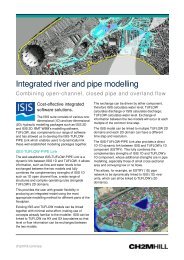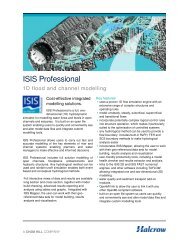December 2008 - Halcrow
December 2008 - Halcrow
December 2008 - Halcrow
Create successful ePaper yourself
Turn your PDF publications into a flip-book with our unique Google optimized e-Paper software.
Towering success<br />
<strong>Halcrow</strong> had cause to celebrate as<br />
consultant on Bahrain’s Financial Harbour,<br />
when it was named best commercial<br />
development at the recent Arabian<br />
Property Awards.<br />
Held at the Madinat Jumeirah resort in<br />
Dubai, the awards highlight world-class<br />
developments that represent the pinnacle<br />
of design, functionality and innovation. The<br />
£1.5 billion harbour is a fully integrated<br />
development for a financial city and selfcontained<br />
community, right in the centre of<br />
Manama, Kingdom of Bahrain.<br />
As consultant to the Bahrain Financial<br />
Harbour Holding Company, <strong>Halcrow</strong> was<br />
commissioned to validate and rework the<br />
concept plan to meet the development’s<br />
gross floor area targets and provide a mix of<br />
land use that was sustainable for<br />
the existing infrastructure.<br />
<strong>Halcrow</strong> also designed and<br />
supervised the construction<br />
of the reclamation areas and<br />
elements of the harbour’s<br />
marina. Plot development guidelines, a car<br />
parking assessment, landscape frameworks<br />
and an overall three dimensional masterplan<br />
and urban design models were also created.<br />
Covering 380,000m 2 of reclaimed land<br />
in Mina Al Manama – the city’s old<br />
trading harbour – Bahrain’s Financial<br />
Harbour combines business, leisure<br />
and residential districts. Just 15<br />
minutes from Bahrain International<br />
Airport, this waterfront development<br />
will cater for 7,000 residents, with<br />
work for a further 8,000 people.<br />
Good vibrations<br />
When Anglian Water’s new pipeline<br />
ran into an immovable obstacle in the<br />
shape of the A12 dual carriageway,<br />
the only viable option was to tunnel<br />
under the road to connect the<br />
excavated pipe trenches on either<br />
side of the busy thoroughfare.<br />
<strong>Halcrow</strong>’s geospatial expertise was<br />
sought to observe ground movement<br />
and identify any risk of settlement<br />
damage caused by the tunnel’s<br />
construction. Led by <strong>Halcrow</strong>’s<br />
Chris Hall and Andrew Baines, the<br />
work was carried out as part of the<br />
Horkesley to Cowdray Avenue water<br />
mains replacement scheme.<br />
The unrelenting stream of traffic<br />
roaring down the A12 posed an<br />
obvious challenge, preventing the<br />
team from physically surveying the<br />
road. Traffic was diverted from the<br />
central lanes overnight while precise<br />
monitoring targets were installed,<br />
allowing surveyors to measure from<br />
the safety of the side verges.<br />
Laser scanning techniques in tandem<br />
with daily precise levelling checks<br />
ensured that any changes in the<br />
road’s stability from the tunnelling<br />
below would be picked up quickly by<br />
the <strong>Halcrow</strong> monitoring team and fed<br />
back to the client.<br />
Breathing new life into bygone bridge<br />
Aberdeen’s historic Wellington Suspension Bridge has reopened after a<br />
seven year hiatus, thanks to inspired work by <strong>Halcrow</strong>’s Scottish team.<br />
<strong>Halcrow</strong> also provided engineering<br />
survey support to the tunnelling<br />
contractor to ensure that everything<br />
was built in exactly the right place.<br />
Wellington Bridge, a testament to Captain Brown’s ingenuity<br />
<strong>Halcrow</strong> initially undertook an inspection<br />
of the bridge, built in 1830, following which<br />
sections of the chains were removed,<br />
examined, and found to be badly corroded.<br />
In addition to designing replacement<br />
stainless steel chains, the team managed<br />
the Aberdonian landmark’s refurbishment,<br />
adding a new timber deck, re-painted<br />
metalwork and re-pointed granite masonry to<br />
complete the face-lift. All works adhered to<br />
Historic Scotland’s requirements.<br />
Aberdeen City Council’s Lord Provost cut<br />
the red ribbon on 3 September <strong>2008</strong>, giving<br />
the city’s pedestrians and cyclists their first<br />
glimpse of the restored structure.<br />
In recognition of the quality work carried out<br />
by the team – David Hodson, Chris Short,<br />
Anne Kerr and Brian Whittle – <strong>Halcrow</strong><br />
has been commissioned to design an<br />
architectural lighting scheme for the bridge.<br />
Captain Samuel Brown<br />
chain bridge pioneer<br />
Captain Brown hung up his naval uniform<br />
in 1812 with several lucrative contracts<br />
to his name, and a series of chain cable<br />
patents that stood practically unchanged<br />
for the next 100 years.<br />
After establishing Samuel Brown and Co to<br />
manufacture chains, Brown made his first<br />
foray into bridge design and construction.<br />
Suspended over the River Tweed, Union<br />
Bridge was completed in 1820, making<br />
it Britain’s first vehicular suspension<br />
bridge. Aberdeen’s Wellington Bridge was<br />
the seventh chain-supported structure<br />
designed and built by Brown’s company.<br />
Millimetre perfect<br />
• Surveyors took measurements<br />
on the same set of known<br />
points each day<br />
• Survey monuments were<br />
established prior to tunnelling<br />
and were checked regularly to<br />
an accuracy of 1mm<br />
• The level survey proved there<br />
was no substantial movement<br />
of the embankment during the<br />
tunnelling work<br />
• The laser scanner survey<br />
showed no significant<br />
ground movement of the two<br />
carriageway surfaces

















